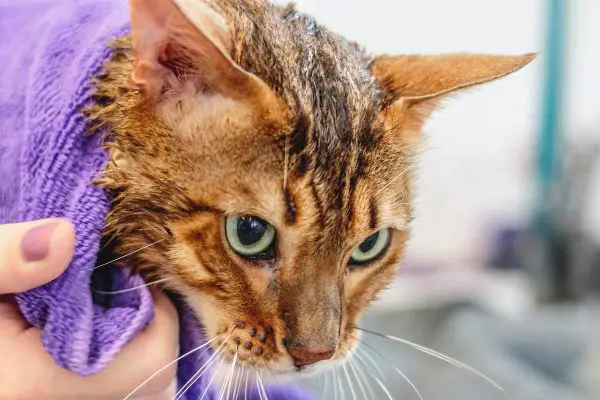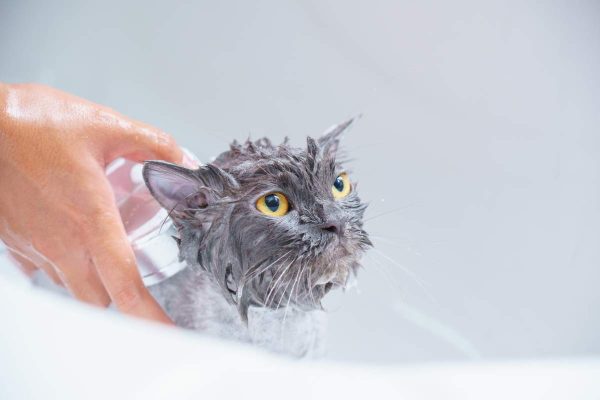There’s nothing quite as unpleasant as opening the door to let your cat in and discovering that he has somehow gotten into something stinky. Even though your cat seems perfectly fine with smelling like rotting fish or some other horrible substance, you are not! It’s time to take things into your own hands and give your cat a bath.
Will my cat hate me if I give him a bath? He likely won’t be happy about it, and you may get bitten and scratched in the process of bathing him, but it’s very unlikely that your cat will hate you after you’ve given him a bath.
As you read on, you will learn when it’s appropriate to bathe your cat, how to make sure your cat is used to water, and how to bathe your cat properly to make sure that the experience is as painless as possible for both of you.
Cats and Water

It’s important to first understand why cats generally dislike water so much. Your cat may be curious about a faucet or a puddle, but hates the whole idea of getting wet, even though it spends time carefully grooming itself every day.
The reason behind cats’ aversion to water lies in their ancestral origins—the Middle East. They began as desert hunters, domesticated by peoples living in dry regions of the world, and therefore, they have not evolved to tolerate water like domestic pets like dogs have.
Dogs, unlike cats, often have fur that can repel or resist water, or can still function to insulate them while wet. Cats, on the other hand, have much finer, softer fur that is not designed to get wet: their fur absorbs water, sticks to their skin, and acts to lower their overall body temperature, making them feel heavy, cold, and thoroughly miserable.
So in short, cats hate water because they never evolved to tolerate it, and so when they get wet, they are extremely physically uncomfortable. No wonder baths seem so repellant to your cat!
To Bathe or Not to Bathe
There is some debate surrounding baths for cats. People who have owned dogs or do own dogs as well as cats are more comfortable with bathing their pets because dogs don’t have careful personal grooming routines like cats do. Maybe once a month or so, your dog needs a bath, and so you give them one.
Cats, however, are much different. Cats groom and clean themselves quite consistently without any human input—in fact, anywhere from 30% to 50% of your cat’s day is spent grooming! It’s an incredibly important part of your cat’s life, and serves to regulate body temperature, prevent and eliminate parasites, and also maintain overall body condition and even emotional health.
Therefore, you should not have to bathe your cat regularly, and it may actually be unhealthy for your cat to be bathed on a schedule like a dog might be. Constant water baths can dry out and damage your cat’s skin and coat, make them hypothermic and ill, and leave them stressed out and unhappy, so it’s best to just allow your cat to do it themselves.
Most cats do an excellent job without any human input at all.
Alternatives to Baths
If your cat is just a little dirty, it may be best to skip the bath altogether and go with a less drastic options. Brushing your cat with a cat-friendly brush, something with rubber or bristle teeth that won’t pull their fur, can be a great bonding exercise for you and your cat, and can even help your cat feel happier and more relaxed.
Your grooming efforts may even reduce the incidence of hairballs, something that you should be on the lookout for as they are not ‘normal’ cat behavior. If your cat has just a small patch of dirt, just using a damp cloth and a thorough brushing should solve the problem without the need for a full-on bath.
However, if your cat is really dirty, has soiled itself, has a parasite infestation, or has an infection like ringworm or scabies which needs to be treated with a medicated shampoo, an actual bath will be necessary.
Accustoming Your Cat to Water
As with training an animal to do anything, starting small and carefully is the best course of action. Ideally, you will be able to start when your cat is a kitten and very gently and patiently expose your kitten to water. Do not immediately soak your cat, as this can be dangerous and make them very sick.
Instead, start with a little water on the paws, then on the legs, and work very slowly toward getting them wet all over. This will take a good deal of time and lots of treats and praise, but it will eventually work.
While kittens are far more understanding and willing to explore new experiences than full-grown cats, but the same rules apply to adult kitties: start slowly, give lots of praise and rewards, and eventually, your cat will begin to tolerate water, if not enjoy it.
As always, be careful and patient, and try not to pressure your cat to the point of lashing out at you. Injuries as a result of trying to do what’s best for your cat are not worth it, and a stressed out and frantic cat is unpleasant for everyone involved.
Bathing Your Cat

When giving your cat a bath, it’s best to prepare in advance. Have your towels, cat-friendly shampoo, and other necessities like brushes, combs, conditioner or medication and other cat-bathing items set aside and ready, so you can grab them quickly and avoid keeping your cat waiting in the tub.
It’s also wise to give your cat something grippy to stand on in the tub, so they don’t slip and fall in the water. You will also likely need an assistant in case your cat becomes too wild to hold onto while you’re bathing them. Teamwork is always a good thing, especially when bathing a grumpy cat! Now, on to the actual bath:
- First, fill the tub with about four inches of warm water—do not fill it all the way, as your cat is not a swimmer, and submerging them completely is dangerous and stressful for your cat.
- Catch your cat. This might be difficult if your cat is anticipating a bath, so take precautions to avoid injuries, like wrapping your cat in a towel when you pick them up.
- Gently place your cat in the tub, then start to wet them down, avoiding their head, ears, and eyes, as these are very sensitive, and should be washed separately with a damp cloth if necessary. Do not use soap anywhere near their eyes. If the sound of the showerhead seems to bother your cat, use cups of water to bath your cat instead.
- Lather your cat wherever there is fur, being gentle and patient as you go. Avoid making loud noises or abrupt gestures, as this will likely stress your cat out further. Try to make the bath as pleasant as possible, like a good cuddle session with your pet.
- Rinse your cat, still avoiding their head. If some soap has gotten on their head or near their face, do not spray your cat in the face, or try to splash water there. Instead, use your damp, soap-free washcloth to help wipe away the soap until your cat is clean again.
- One your cat is thoroughly rinsed, drain the water from the tub and bring out the towels. Dry your cat promptly and gently, removing as much water as you can with the towels—this will help to prevent them from getting chilled and possibly sick.
- Finally, allow your cat to fully airdry in a warm place, or blow dry them on a warm, NOT hot, setting, if they will tolerate it.
It may look simple on paper, but in reality, the actual bath itself might take longer than anticipated, and may involve slightly more unhappy cat noises and scratches. As always, the key is patience and kindness: if your cat understands and feels that you are not trying to hurt or endanger them, they will stay calmer, and the whole process will go a lot smoother.
Why Does My Cat Hate Me?
The perception that a cat “hates” its owner can often be rooted in misunderstandings of feline behavior. Cats are independent animals with unique personalities, and their actions are shaped by various factors. A cat may not harbor feelings of hatred. Instead, certain behaviors might stem from stress, fear, or discomfort.
Cats communicate differently than humans, and what might be perceived as rejection or animosity is often a cat expressing its need for space or asserting independence. Cat owners need to understand feline body language, provide a comfortable environment, and ensure the cat’s physical and emotional needs are met to foster a positive and trusting relationship. Patience, gentle interactions, and respect for the cat’s boundaries can help strengthen the bond between a cat and its owner.
Conclusion
Like any pet owner, you care about your cat’s happiness and wellbeing. Baths will likely never be your cat’s favorite thing in the world, but they are occasionally a necessary part of cat ownership.
While it’s often preferable to do the gentler, “water-free” grooming option, a full-on tub bath may be needed to make sure your cat is at their best, especially if the problem at hand is a medical one. So, if a bath is inevitable, making sure that both you and your cat are ready for it is key to a painless experience.
Be as efficient and gentle as possible, and your cat, though likely unhappy with the whole event, will not hate you, and both of you will go on about your lives as usual, but perhaps smelling a bit sweeter.
Of course, if bathing your cat seems like too much of a challenge and you’re concerned that your cat may seriously hurt itself or you, you can always find a professional to help you out. Regardless, a clean cat is a happy cat, so no matter how much your pet may dislike the bath itself, the result will be good for both of you!


